On this page
Books about CranesThe books are listed in order of publication date with the most recent at the top.
Cranes
Family: Gruidae
UK
Common Crane
(Eurasian Crane)
Grus grus
Rest of world
Sandhill Crane
Grus canadensis
Whooping Crane
Grus americana
Sarus Crane
Grus antigone
Brolga
Grus rubicunda
Siberian Crane
Grus leucogeranus
White-naped Crane
Grus vipio
Hooded Crane
Grus monacha
Black-necked Crane
Grus nigricollis
Red-crowned Crane
Grus japonensis
Blue Crane
Anthropoides paradisea
Demoiselle Crane
Anthropoides virgo
Wattled Crane
Bugeranus carunculatus
Black Crowned Crane
Balearica pavonina
Grey Crowned Crane
Balearica regulorum
|
|
|
|
Those of the Gray Wind: The Sandhill CranesPaul A. Johnsgard
Bison Books
2nd edition
2017
"With Paul A. Johnsgard, we follow the migration of the sandhill cranes from the American Southwest to their Alaskan breeding grounds and back again, an annual pattern that has persisted over millions of years. By selecting four historic time frames of the migration between 1860 and 1980, Johnsgard illustrates how humans have influenced the flocks and how different American cultures have variously responded to the birds and perceived their value. Each section focuses on the interactions between children of four different American cultures and sandhill cranes, triggered by events occurring during the annual life cycle of the cranes. The story is enriched by the author's exquisite illustrations, by Zuni prayers, and by Inuit and Pueblo legends. Originally published in 1986, this new edition features a new preface and afterword and a new gallery of photographs by the author, Those of the Gray Wind is a classic story of a timeless ritual that can be enjoyed for generations to come."
|
Buy from amazon.co.uk 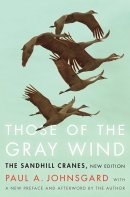
|
|
Cranes, Herons and Storks of AustraliaDavid Hollands
Bloomings Books
2016
"David Hollands has spent 16 years traversing Australia to find, study and photograph the 17 species which make up this book. His passion and enthusiasm for his subjects shine through in the text; lively, accurate, informative and beautifully written, not only about the birds but about the expeditions to find them. The book is richly illustrated with over 200 of the author's photographs."
|
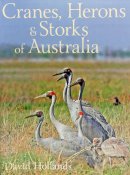 |
|
A Chorus of Cranes: The Cranes of North America and the WorldPaul A. Johnsgard
Photographs: Thomas D. Mangelsen
University Press Of Colorado
2015
"Accompanied by the stunning photography of Thomas D. Mangelsen, A Chorus of Cranes details the natural history, biology, and conservation issues surrounding the abundant sandhill crane and the endangered whooping crane in North America. Author Paul A. Johnsgard, one of the leading authorities on cranes and crane biology, describes the fascinating social behaviors, beautiful natural habitats, and gruelling seasonal migrations that have stirred the hearts of people as far back as medieval times and garnered the crane a place in folklore and mythology across continents. Johnsgard has substantially updated and significantly expanded his 1991 work Crane Music, incorporating new information on the biology and status of these two North American cranes and providing abbreviated summaries on the other thirteen crane species of the world. The stories of these birds and their contrasting fates provide an instructive and moving history of bird conservation in North America. A Chorus of Cranes is a gorgeous and invaluable resource for crane enthusiasts, birders, natural historians, and conservationists alike.
|
Buy from amazon.co.uk 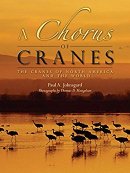
|
|
Cranes, Herons & Egrets: The Elegance of Our Tallest BirdsStan Tekiela
Advance Publishing
2015
"Award-winning photographer Stan Tekiela takes you into the fascinating world of cranes, herons and egrets. His striking photography captures the birds in action and depicts behaviors that will leave you awestruck......These historic birds are ingrained in folklore around the world. Stan has photographed every important aspect of their lives, from first flight and hunting to migration and mating.
|
Buy from amazon.co.uk 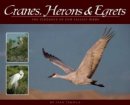
|
|
Back from the BrinkMalcolm Smith
Whittles Publishing
2015
"Back from the Brink is an antidote to a world that seems full of stories of wildlife doom and gloom. Amongst all the loss of habitat and the animals and plants that are in spiralling decline, it's easy to forget that there are a huge number of positive stories too; animals threatened with extinction, such as the gigantic European Bison - extinct in the wild - having their fortunes reversed and their futures secured. This is the story of some of these successes." The book comprises fifteen chapters each covering a specific species or groups of species. There are six bird related chapters: Wild Turkey, Houbara Bustard, India's Vultures, Whooping Crane, Zino's Petrel and Mauritius Kestrel.
|
Buy from amazon.co.uk 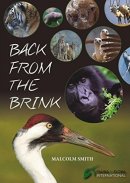
|
|
The Man Who Saved the Whooping Crane: The Robert Porter Allen StoryKathleen Kaska
University Press of Florida
2012
"Millions of people know a little bit about efforts to save the whooping crane, thanks to the movie Fly Away Home and annual news stories about ultralight planes leading migratory flocks. But few realize that in the spring of 1941, the population of these magnificent birds - pure white with black wingtips, standing five feet tall with a seven-foot wingspan - had reached an all-time low of fifteen. Written off as a species destined for extinction, the whooping crane has made a slow but unbelievable comeback over the last seven decades. This recovery would have been impossible if not for the efforts of Robert Porter Allen, an ornithologist with the National Audubon Society, whose courageous eight-year crusade to find the only remaining whooping crane nesting site in North America garnered nationwide media coverage. His search and his impassioned lectures about overdevelopment, habitat loss, and unregulated hunting triggered a media blitz that had thousands of citizens on the lookout for the birds during their migratory trips. Allen's tireless efforts changed the course of U.S. environmental history and helped lead to the passage of the Endangered Species Act in 1973. Though few people remember him today, his life reads like an Indiana Jones story, full of danger and adventure, failure and success. His amazing story deserves to be told."
|
Buy from amazon.co.uk 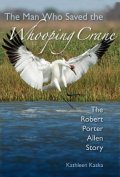
|
|
The Norfolk Cranes' StoryJohn Buxton and Chris Durdin
Includes Cranes In Europe by Nick Upton
The Norfolk Cranes' Story
2011
"This book tells the story of how cranes bred at Horsey in Norfolk, and how they were protected and studied there. The cranes' story starts with their arrival at Horsey in 1979. Their first nesting attempt was in 1981 and the first chick fledged in 1982. from this slow start in the Broads, the re-colonisation of this iconic wetland bird is now taking small but steady steps forwards elsewhere in the UK. Their guardian at Horsey was – and is – John Buxton. Much of what we know about cranes in the UK was contained in John's memory and notebooks. The co-author is Honeyguide's Chris Durdin. With John providing the information and Chris doing the writing, this was how the book was completed. Part one, 'The Horsey Story' tells the story of cranes at Horsey in John's words, as told to Chris. Much of this draws on John's memories and the many and detailed notebooks that John kept. Added to these are the diaries, reports and recollections of others, such as Peter Allard, Mike Everett and several crane wardens. Part two, Cranes: History, Observations and Management includes the history of cranes in the UK, how ‘Crane Country' was shaped, and information on land management as it affects crane habitats for breeding and feeding. Observations on their behaviour at Horsey show the time and energy that John Buxton and his team of wardens have dedicated to cranes. The difficulty of access into fens and the birds' secretive and sensitive nature make the observations made at Horsey especially valuable. We hope these will prove useful to land managers elsewhere in the UK as crane numbers increase. Though this book is primarily about Norfolk's cranes, the common crane is the most widely distributed of the 15 crane species. In part three, Cranes in Europe, Nick Upton describes the challenges facing cranes in the rest of Europe, charting their recent rise in numbers that has contributed to their reappearance in the UK."
|
Buy from amazon.co.uk 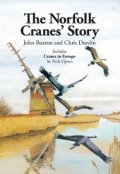
|
|
Sandhill and Whooping Cranes: Ancient Voices Over America's WetlandsPaul A Johnsgard
Bison Books
2011
"Johnsgard has spent nearly a half century observing cranes, from a yearly foray to Nebraska's Platte River valley to see the spring migration, to pilgrimages to the birds' wintering grounds in Arizona and nesting territory in Alaska. In this book he draws from his own extensive experience as well as the latest science to offer a richly detailed and deeply felt account of the ecology of sandhill and whooping cranes and the wetlands in which they live. Incorporating current information on changing migration patterns, population trends, and breeding ranges, Johnsgard explains the life cycle of the crane, as well as the significance of these species to our natural world. He also writes frankly of the uncertain future of these majestic birds, as cranes and their habitats face the effects of climate change and increasing human population pressures. Illustrated with the author's own ink drawings and containing a detailed guide to crane-viewing sites in the United States and Canada, this book is at once an invaluable reference and an eloquent testimony to how much these birds truly mean."
|
Buy from amazon.co.uk 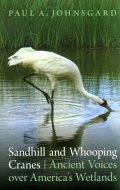
|
|
Whooping Crane: Images from the WildKlaus Nigge
Texas A & M University Press
2010
"Approximately 250 wild whooping cranes nest in northern Canada and winter in south Texas, flying 2,500 miles annually between these two distinct havens. Each of these terminal migratory places is protected from human encroachment, by a U.S. national wildlife refuge on the one hand and a Canadian national park on the other. On the flock's wintering grounds at Aransas National Wildlife Refuge in Texas, photographer Klaus Nigge has captured the daily activity of a single family over several weeks in two separate years, documenting their life in the salt marshes of the central Texas coast. He has also photographed the cranes' summer nesting sites in remote areas of Wood Buffalo National Park. The photographs in this book are accompanied by vignettes composed by the author."
|
Buy from amazon.co.uk 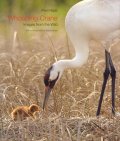
|
|
Cranes of the World in 2008: A Supplement to Crane MusicPaul A. Johnsgard
University of Nebraska–Lincoln Libraries
2008
Excerpt: "An overview of the current status of the world's cranes is perhaps in order, to bring up to date the accounts given earlier in Crane Music, which was written nearly 20 years ago. The accompanying table presents an updated (as of about 2004-2008) summary of world crane distribution and status, which shows some significant differences from the similar table presented in the first edition of that book. Some of these differences are the likely result of more complete and more accurate surveys, such as the substantially increased estimate of the black-necked crane's population, previously thought to number only about 1,600 birds. The same factor may help account for the larger estimates shown for the Siberian crane and blue crane."
|
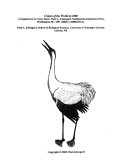 |
|
Cranes: A Natural History of a Bird in CrisisJanice M. Hughes
Firefly
2008
"Cranes traces the history of these fascinating birds from their early origins in the Mesozoic Era to the present day. The book covers anatomy, feeding habits, mating rituals, habitats, caring for the chicks, migration and seasonal movements. A special section is devoted to cranes in myth and folklore. Species profiles are included, along with range maps and conservation status of: Black-Crowned Crane; Red-Crowned Crane; Black-Necked Crane; Sandhill Crane; Blue Crane; Sarus Crane; Brolga Siberian Crane; Demoiselle Crane; Wattled Crane; Eurasian Crane; White-Naped Crane; Grey Crowned Crane; Whooping Crane; Hooded Crane. Emphasis is given to the Whooping Crane as a case study of the environmental and human pressures that threaten the existence of all family members. Through the tireless efforts of many dedicated researchers and volunteers, this species is slowly being brought back from the edge of extinction. Operation Migration, the project to establish a migratory population of whooping cranes in the eastern United States, is profiled in a special chapter of Cranes."
|
Buy from amazon.co.uk 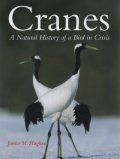
|
|
The Magic of CranesCarl-Albrecht von Treuenfels
ABrams
2007
"Carl-Albrecht von Treuenfels has spent decades observing and photographing cranes, and in this dazzling collection, he offers overwhelming evidence why we must strive to ensure their survival. This beautiful volume includes maps depicting the birds' flight routes; guides to where cranes can be seen in their natural habitats; and detailed information on how they live, their elaborate and noisy courting dances, how they nurture their young, and how they migrate each winter in V-shaped formations."
|
Buy from amazon.co.uk 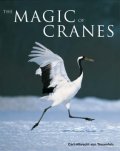
|
|
Brolga Country: Travels In Wild AustraliaMitch Reardon
Allen and Unwin
2007
"On assignment in outback Australia, wildlife photographer and writer Mitch Reardon encounters a rancher whose infectious desire to protect the habitat of Australia's only native crane, the Brolga, inspires him to go on a journey to find these magnificent birds. Brolga Country records Reardon's progress through some of Australia's wildest and most remote country, from the wilderness of Cape York Peninsula where the sprawling rivers, billabongs, lakes and swamps of Lakefield National Park support vast assemblages of wetland birds to Bool Lagoon in South Australia, the last stronghold of the southern Brolgas."
|
Buy from amazon.co.uk 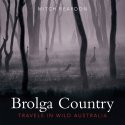
|
|
The Eurasian Crane in EstoniaA. Leito, J. Kespaik, I. Ojaste and J. Truu
Estonian University of Life Sciences
2006
"The book presents the most notable results of the studies of Eurasian Cranes in Estonia. The book consists of eight topical chapters, a short introduction and conclusions, and the list of sources used. Nesting migration, population numbers and distribution of Eurasian Cranes receive here a more thorough treatment. Additionally, moulting is also discussed and an overview of the history of Eurasian Crane study and conservation in Estonia is provided."
|
Buy from amazon.co.uk 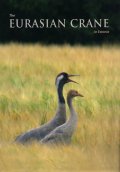
|
|
Cranes: Where, When and Why? : A Guide Book for Visitors in European Crane Areas and Ideas How to Manage Cranes in an Agricultural EnvironmentEditor: Göran Lundin
Swedish Crane Working Group
2005
A guide to the different sites in Europe that host cranes, with specific information about 16 sites in Finland, Sweden, Estonia, Germany, France, Spain and Hungary. Other sections are: Cranes as a resource; Crane's world today; The feather; Colour-ringing of cranes; Moulting of cranes; List of references.
|
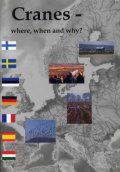 |
|
On Ancient Wings: The Sandhill Cranes of North AmericaMichael Forsberg, George W. Archibald, and James Harris
Michael Forsberg Photography
2005
"With stunningly beautiful photographs, On Ancient Wings presents Sandhill Cranes in their wild but increasingly compromised habitats today. Over the course of five years, Michael Forsberg documented the tall gray birds in habitats ranging from the Alaskan tundra, to the arid High Plains, from Cuban nature preserves to suburban backyards. With an eye for beauty and an uncommon persistence, the author documents the cranes' challenges to adapt and survive in a rapidly changing natural world. Forsberg argues that humankind, for its own sake, should secure the cranes' place in the future. On Ancient Wings intertwines the lives of cranes, people, and their common places to tell an ancient story at a time when Sandhill Cranes and their wetland and grassland habitats face daunting prospects."
|
Buy from amazon.co.uk 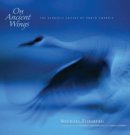
|
|
The San Luis Valley: Sand Dunes and Sandhill CranesSusan J. Tweit
University of Arizona Press
2005
"With the precision of a scientist and the passion of a poet, she guides readers through this land of sand dunes and sandhill cranes, describing its natural features and tracing its human history from buffalo hunters and conquistadors to Hispanic farming communities and UFO observatories. And in stunning images, photographer Glenn Oakley brings his intimate feel for light and landscape to portraying not only the subtle beauty of this high-desert sanctuary but also the grandeur of the cranes in flight."
|
Buy from amazon.co.uk 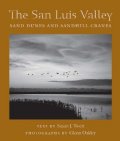
|
|
Following The Sandhill Cranes In Colorado: Enticed Into BirdingEvelyn Horn
Western Reflections Publishing
2004
"Following the Sandhill Cranes in Colorado is an intimate journey of discovery, as seen through the eyes of author Evelyn Horn. This captivating book expresses the author's love affair with nature. Birds are especially of interest; in particular, the majestic sandhill cranes that populate, among other places, Hart's Basin in western Colorado."
|
Buy from amazon.co.uk 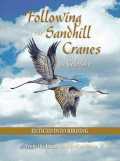
|
|
The Birds of Heaven: Travels with CranesPeter Matthiessen
Illustrations: Robert Bateman
Vintage
2003
Originally published in 2001
"In The Birds of Heaven, Peter Matthiessen has woven his accounts of journeys undertaken over more than a decade in search of the fifteen remaining species of crane. From the scarcely populated Amur Valley in Siberia, he travels gradually west and south across Asia, through Australia, Africa and Europe (where the crane population has made a resurgence), ending up in the American Gulf Coast. He is joined by conservationists, scientists and enthusiasts of all nationalities, along with indigenous people - from Mongolian herdsmen to Aboriginals in Australia - whose fates are entwined with the cranes."
|
Buy from amazon.co.uk 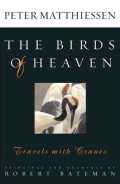
|
|
Cranes: The Noblest Flyers in Natural History and Cultural LoreA.Lindsay Price
University of New Mexico Press
2001
"Alice Lindsay Price, a devoted naturalist, has for the past twenty years joined the scientific pursuit of avian scholarship to her lifelong passions of painting, writing, and literature. Here, she brings into focus the wealth of human lore, both scientific and cultural, to portray the survival into the twenty-first century of the two North American Crane species, the Sandhill and the Whooping Crane. Her comprehensive display of facts and lore interwoven into her own observations in the field - as well as those of scientists and naturalists working to save the species from extinction - remind us how essential is our awareness of the natural world. The book is illuminated with illustrations and photographs by the author, and with a wide assortment of historical images from Cretan bird goddess to petroglyphs to Audubon."
|
Buy from amazon.co.uk 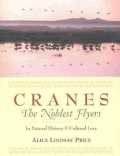
|
|
Wings Across the Desert: The Incredible Motorized Crane MigrationDavid H. Ellis
Hancock House Publishers
2001
"This book documents a quest to determine if a flock of cranes could be trained to follow a truck on a long-distance migration and arrive wild enough to survive after release."
|
Buy from amazon.co.uk 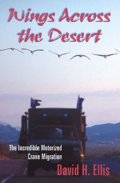
|
|
The Birds of Heaven: Travels with CranesPeter Matthiessen
Illustrations: Robert Bateman
Greystone
2001
"In legend, cranes often figure as harbingers of heaven and omens of longevity and good fortune. And in nature, they are an "umbrella species" whose well-being assures that of the ecosystem at large. The Birds of Heaven chronicles Peter Matthiessen's many journeys on five continents in search of the fifteen species of cranes. His telling captures the dilemmas of a planet in ecological crisis, and the deep loss to humankind if these beautiful and imposing creatures are allowed to disappear."
|
Buy from amazon.co.uk 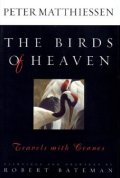
|
|
Save the CranesA. Greshnevikov
Pensoft Publishers
2001
|
Buy from amazon.co.uk 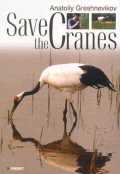
|
|
Legends of the CranePamela J. Jensen
Sandstone Press
2000
Folklore and poems about cranes, egrets and herons.
|
Buy from amazon.co.uk 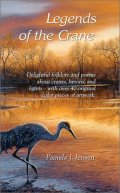
|
|
Crane Music: A Natural History of American CranesPaul A. Johnsgard
Bison Books
1998
"Graced with illustrations by the author, "Crane Music" introduces the two North American crane species. The sandhill, most often seen, is within easy reach of bird-watchers in the center of the continent. Less visible is the whooping crane, struggling back from near extinction. Paul Johnsgard follows these elegant birds through a year's cycle, describing their seasonal migrations, natural habitats, breeding biology, call patterns-angelic to the bird-lover's ear-and fascinating dancing."
|
Buy from amazon.co.uk 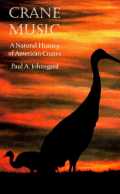
|
|
Cranes Grus grus in NW-Russia, autumn 1996T. Veerman & H. Wessels
WIWO Report 59
Working Group International Waterbird and Wetland Research
1998
"In 1996 research was done in the northwestern part of European Russia (district Kargopol) into cranes. These birds use this area as halfway stage on their route from their nesting ground to their wintering place. In order to map this migratory route it was decided to catch a number of these birds and give them coloured rings. It was tried to lure them to a feeding field on which grain mixed with the anaesthetic alphacholoralose was scattered."
|
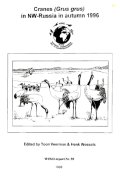 |
|
Sandhill CranesLynne M. Stone
Lerner Publications
1997
"Describes the physical characteristics, habitat, behavior, and life cycle of one of the tallest birds in North America."
|
Buy from amazon.co.uk 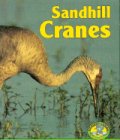
|
|
The Cranes: Status Survey and Conservation Action PlanC.D. Meine and G.W. Archibald
IUCN: The World Conservation Union
1996
This book provides biological information, updated species status reports, and recommendations for the conservation of crane species.
|
Buy from amazon.co.uk 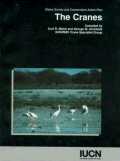
|
|
The Whooping Crane : North America's Symbol of ConservationJerome J. Pratt
Castle Rock
1996
"With the taming and development of this land, however, this species almost vanished. By the 1940s there were only 20 left. The species, characterized now as the "Symbol of North American Conservation," has been brought from the brink of oblivion, and now in 1966 numbers close to 200. The success of the recovery effort is due to the work of a wide range of dedicated people over a half-century. These were aviculturists, biologists, federal, state, and provincial officials, zoo keepers, and a far-sighted U.S. Congress. This book is their story and is compiled by one of those most directly involved in the crane's recovery--Jerome J. Pratt. A founding member of the Whooping Crane Conservation Association."
|
Buy from amazon.co.uk 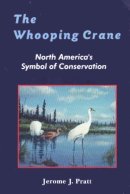
|
|
Cranes: Their Biology, Husbandry and ConservationEditor: David H. Ellis, George F. Gee and Claire M. Mirande
Hancock House
1996
"Topics covered include: crane biology; general husbandry; egg and semen production; incubation and hatching; veterinary techniques for rearing crane chicks; behaviour management; imprinting, attachment, and behavioural development in cranes; reproductive physiology; medicine and surgery; genetic management; records; special techniques; artificial insemination; cryopreservation; sex determination; reintroduction techniques; flight restraint; predator and pest management; facilities; ecology, status, and conservation."
|
Buy from amazon.co.uk 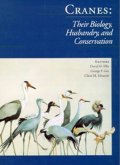
|
|
Handbook of the Birds of the World, Vol. 3: Hoatzin to AuksEdited by Josep Del Hoyo, Andrew Elliott and Jordi Sargatal
Illustrations: Norman Arlott, Hilary Burn, Francesc Jutglar, Àngels Jutglar, Ian Lewington, Lluís Sanz, Etel Vilaró, Ian Willis
Lynx Edicions
1996
821 pages, 60 colour plates, colour photos, distribution maps.
This volume covers 30 families including cranes, bustards, rails, gulls, terns, waders and auks.
|
Buy from amazon.co.uk 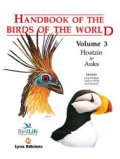
|
|
So Cranes May Dance: A Rescue from the Brink of ExtinctionBarbara Katz
Chicago Review Press
1993
The story of the International Crane Foundation, its founders and its attempts to save crane species.
|
Buy from amazon.co.uk 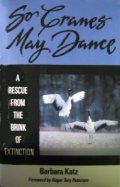
|
|
The Cry of the Sandhill CraneSteve Grooms
Northword
1992
A study of sandhill cranes, especially those along the Platte River in Nebraska. Includes information on feeding techniques, nesting habits, and habitat requirements. Contains an appendix with information on other cranes of the world.
|
Buy from amazon.co.uk 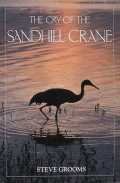
|
|
Crane MusicPaul A. Johnsgard
Volume 79, Number 2, pages 8-19
NEBRASKALand
1992
Opening lines: "Cranes are the stuff of magic, whose voices penetrate the atmosphere of the world's wilderness areas, from arctic tundra to the South African veld, and whose footprints have been left on the wetlands of the world for the past 60 million years or more. They have served as models for human tribal dances in places as remote as the Aegean, Australia, and Siberia. Whistles made from their wing bones have given courage to Crow and Cheyenne warriors of the North American Great Plains, who ritually blew on them as they rode into battle. These birds' wariness, gregariousness, and regularity of migratory movements have stirred the hearts of people as far back as medieval times and probably long before, and their sagacity and complex social behavior have provided the basis for folklore and myths on several continents."
|
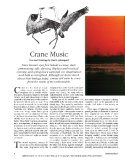 |
|
Where Are My Swans, Whooping Cranes, and Singing Loons?Ron Hirschi
Bantam Dell Pub Group
1992
Describes the lifestyle and habitat of the swan, whooping crane, and loon. Explains how the destruction of wetlands threatens their survival and what we can do to save them.
|
Buy from amazon.co.uk 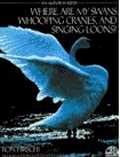
|
|
The Red-crowned CraneEdward Voeller
Prentice Hall
1990
A study which discusses the appearance, behaviour, habitat, and current status of the red-crowned crane.
|
Buy from amazon.co.uk |
|
Return of the Whooping CraneRobin W. Doughty
University of Texas Press
1989
The story of the recovery from near extinction to a population of over 200 birds.
|
Buy from amazon.co.uk 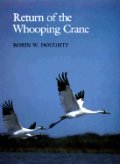
|
|
The Whooping Crane: A Comeback StoryDorothy Hinshaw Patent
Houghton Mifflin
1988
Traces the forty-year-old and ongoing attempt to save the endangered whooping crane from extinction, focusing on efforts at wildlife refuges and the captive breeding program.
|
Buy from amazon.co.uk 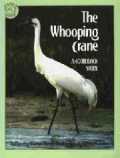
|
|
Social Organization of Sandhill Cranes from Midcontinental North AmericaThomas C. Tacha
Monographs No. 99
Wildlife Society
1988
A 37 page monograph. From the abstract: "Social behavior and relationships of midcontinent sandhill cranes (Grus canadensis) were studied during winter and spring 1978-80 in western Texas, Nebraska, Saskatchewan, and Alaska. Social behaviors were described and frequency of occurrence, duration, and percentages of time allocated to each behavior were compared among age, sex, and social classes."
|
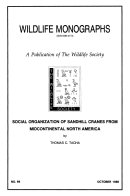 |
|
Cranes Of The WorldPaul A. Johnsgard
Indiana University Press
1983
|
Buy from amazon.co.uk 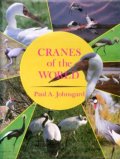
|
|
The Japanese Crane: Bird Of HappinessDorothy Britton and Tsuneo Hayashida
Kodansha Europe
1982
An illustrated work about the Japanese crane.
|
Buy from amazon.co.uk 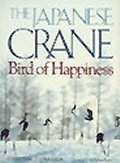
|
|
Those of the Gray Wind: Sandhill CranesPaul A. Johnsgard
St Martins Press
1981
A brief, fictionalized account of the lifecycle of the Sandhill Crane. Includes illustrations by the author.
|
Buy from amazon.co.uk 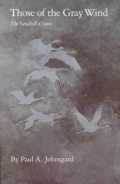
|
|
Status Of Greater Sandhill Cranes In Piceance BasinMichael H. Getman
US Department Of The Interior
1978
A 32 page report. Abstract: Abstract: "The status of the greater sandhill crane (Grus canadensis tabida) was studied in the Piceance Basin Wildlife Management Area of northwestern Colorado from February to May 1976. Greater sandhill cranes were observed to determine if they danced, staged or nested in the Piceance Basin. Habitat factors considered were water, feeding meadows, nesting cover, minimal disturbances, along with the conflicts of proposed oil shale developments. Although one whooping and five sandhill crane sightings were recorded during the spring of 1976, no cranes remained in the area longer than three days. No evidence of cranes dancing, staging, or nesting was found. Results indicate that cranes utilize Piceance Basin during migration as a rest stop and feeding area to avoid nocturnal flying and/or oncoming storm fronts."
|
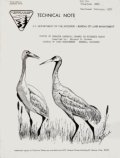 |
|
Cranes Of The WorldLawrence Walkinshaw
Winchester Press
1974
|
Buy from amazon.co.uk 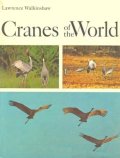
|
|
The Whooping Crane: A Fight Against ExtinctionFaith McNulty
Longmans
1967
This is the UK edition of The Whooping Crane: The Bird That Defies Extinction.
|
Buy from amazon.co.uk 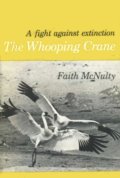
|
|
The Whooping Crane: The Bird That Defies ExtinctionFaith McNulty
Illustrations: Robert Allen, Louis Agassiz Fuertes and others
E.P.Dutton & Co
1966
|
Buy from amazon.co.uk
Buy from amazon.com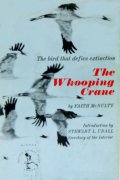
|
|
The Hunt for Whooping Cranes: A Natural History Detective StoryJ.J. McCoy
Paul S. Eriksson
1966 (1996)
The story of the efforts to save the whooping crane from extinction.
|
Buy from amazon.co.uk 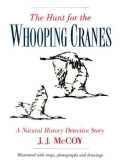
|
|
Whooping CraneRobert M. McClung
Illustrations: Lloyd Sandford
Morrow
1959
A short book tht describes the migration, mating and nesting habits or the Whooping Crane and the dangers that threaten migratory wildlife.
|
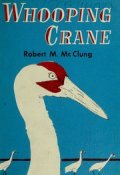 |
|
Whooping CraneRobert Porter Allen
Research Report No. 3
National Audubon Society
1952
A 270 page report.
|
Buy from amazon.co.uk 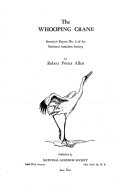
|
|
Catalogue Of The Fulicariae (Ralidae and Heliornithidae) And Alectorides (Aramidae, Eurypygidae, Mesitidae, Rhinochetidae,
Gruidae, Psophiidae, And Otididae) In The Collection Of The British MuseumCatalogue Of The Birds In The British Museum, Volume XXIII
R. Bowdler Sharpe
9 colour plates: J.G. Keulemans
Printed By Order Of The Trustees
Sold by: Longman & Co.; B. Quaritch; Kegan Paul, Trench, Trubner & Co.; and at the British Museum (Natural History)
1894
Preface: "The numbers of the species of the nine families treated of in the twenty-third volume, and of the specimens at present in the Collection, are as follows: Rallidae, 187; Heliornithidae, 4; Aramidae, 2; Eurypygidae, 2; Mesitidae, 1; Rhinochetidae, 1; Gruidae, 19; Psophiidae, 6; Otididae, 30. In the first category 29 forma are included which are considered by the author to be of only subspecific rank, while 33 species and subspecies are still unrepresented in the Collection of the Museum. Beside the 49 types of recognized species, the Collection contains 27 other typical specimens which are now relegated to the synonyms. As in the preceding volumes, the series of specimens of the American and Indian species are derived chiefly from the Hume, Tweeddale, and Godman-Salvin Collections; but they have been largely supplemented by a generous donation from Mr. Seebohn. For other additions to this volume the Trustees are indebted to the Right Hon. Lord Lilford, Colonel Irby, Mr. H. 0. Forbes, Mr. P. L. Sclater, and Mr. F. W. Styan."
|

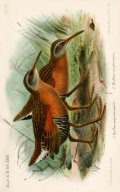
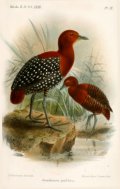 |
|
The Natural History Of CranesEdward Blyth
Greatly enlarged and reprinted by W.B. Tegetmeier
Horace Cox, The Strand, London
1881
From the preface: "The story of this volume is soon told. On the arrival for the first time in this country of a pair of the beautiful white-naped cranes of Japan, they were drawn by Mr. T. W. Wood for The Field, when Mr. E. Blyth, availing himself of the opportunity, published in the columns of that paper a monograph of all the then known species of the Gruidae. These articles were soon exhausted. I thought of reproducing them in a literal reprint, and had proceeded as far as the introduction, when Professor Newton forwarded to me a copy of his article "Crane," in the "Encyclopaedia Britannica." In this he stated "an admirably succinct account of all the different species was communicated by the late Mr. Blyth to The Field newspaper in 1873, which, it is much to be regretted, has not since been published in a more accessible form." This opinion confirmed me in my estimation of the worth of the work, and I endeavoured to render it of more value by the insertion of much matter that limited space had kept out of the original articles, and new information that has appeared since Mr. Blyth's death. Amongst these, I may instance the valuable contributions of the late Col. Tickell on the Indian species, Mr. Wolley's account of the nesting of the common species in Lapland, justly characterised by Professor Newton as "one of the most pleasing contributions to Natural History ever written," Dr. Cullen's account of the nesting of the Demoiselle in Bulgaria, Mr. A. 0. Hume on the Asiatic White Crane, Dr. Coues on the American species, Lieut-Col. Prjevalsky's account of a new species, Mr. Gurney's description of the Southern Crowned Crane, &c., &c. These additions being more than double the amount of the original matter, I have no hesitation in placing my own name on the title-page. The added matter, whether in large or small type, is indicated by being placed in square brackets [thus], so that Mr. Blyth's original contributions are easy of identification."
|
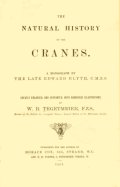
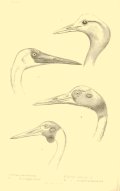
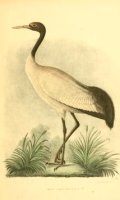 |
|